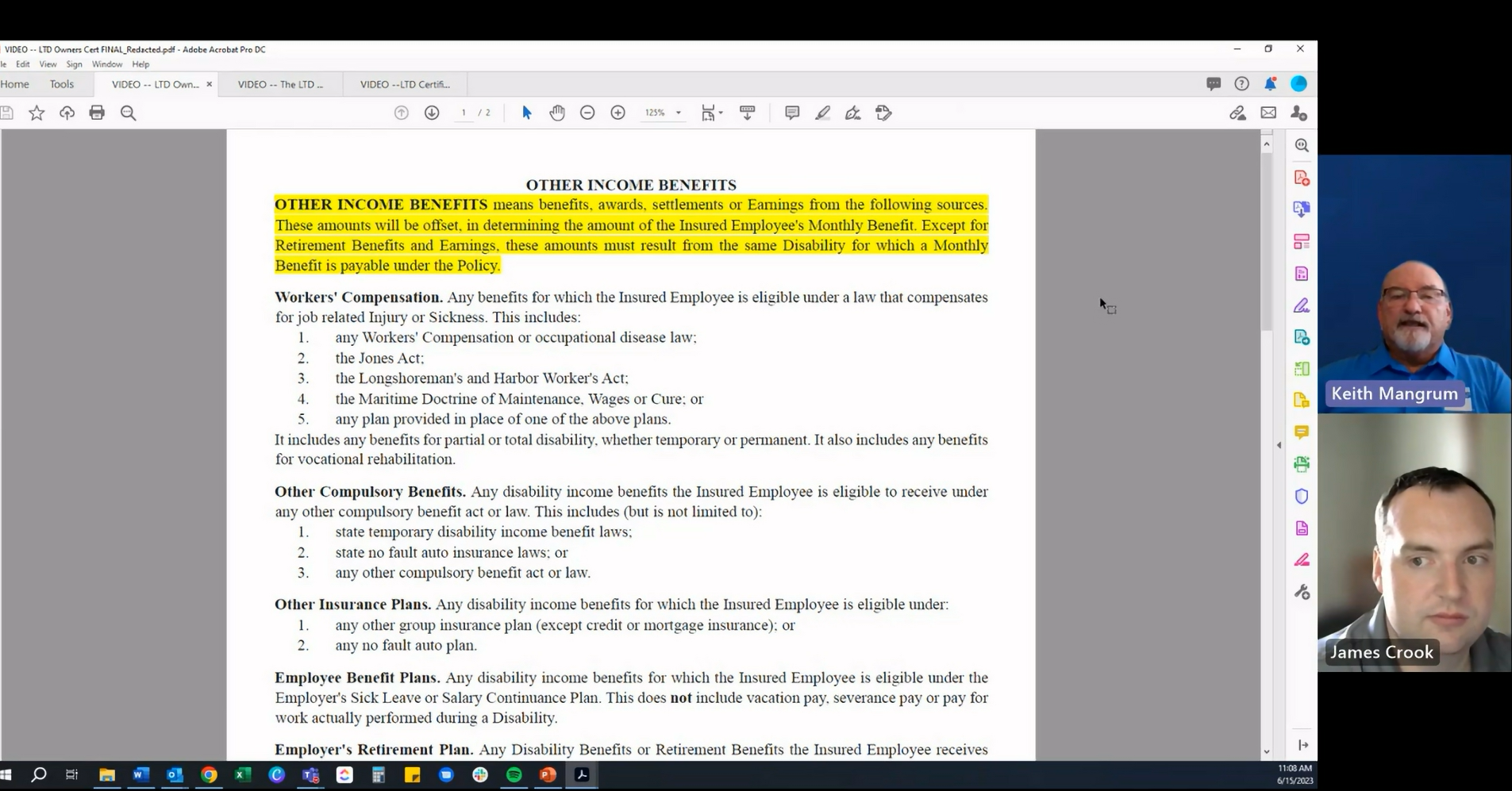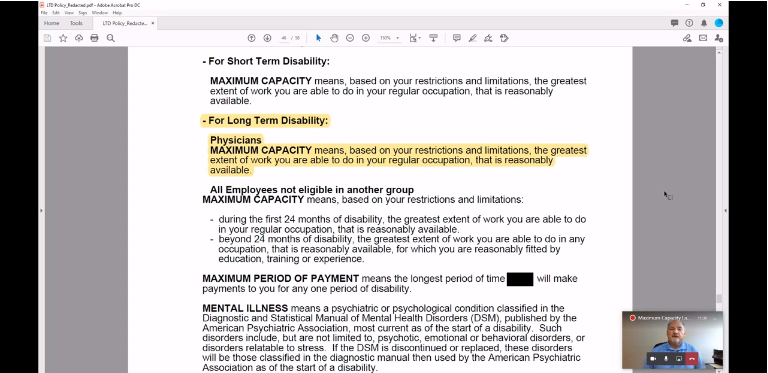Finding Contract Killers – Offsets For Ownership Income
James Crook
James: Hey, everyone. Thanks for watching. Today, I’m joined by Keith Mangrum, senior regional vice president of sales for MGIS in the Southeast Territory. Keith and I are continuing our video series we’re calling Contract Killers where we examine different anonymous LTD contracts that have provisions that could disadvantage your doctor clients at claim time. Today, we’ll be diving deep into offsets for partnership income. [00:00:30] Keith, tell me why this topic is a big deal.
Keith: James, thanks for the opportunity, and here’s why It’s a big deal. Most of the practices that we work with have a single owner doctor or they have partners or they have shareholders, and so those owners of the practice not only receive income from the procedures that they do on a daily basis, but also receive [00:01:00] profits from the practice, typically at year-end. And so, typically, we call that K-1 income because it’s reported on a IRS tax form K. So what we’re finding is that most doctors do not realize or do not understand how the insurance companies will account for that income that they may still receive while they’re disabled, and so [00:01:30] that can be an issue at claim time. Why don’t we take a look at the first-
James: Yeah, absolutely.
Keith: -LTD policy that we have that discusses this.
James: Okay, you should be able to see.
Keith: Okay, so you see highlighted in yellow a section called Other Income Benefits. And the ones that are typically familiar that are in this category would be Social Security disability, [00:02:00] workers’ comp insurance, things that you, as a claimant, might receive while you’re out on a disability. And those are considered other income benefits. And basically, those are a dollar-for-dollar reduction of your benefit. So if your benefit would be 10,000 a month, and, for instance, you’re getting Social Security disability of 4,000 a month, then the insurance company would pay you [00:02:30] 6. You’d receive four from Social Security, so that the total of 10 is what you would expect to get. So that’s fairly common, and that’s in all LTD policies. If you scroll down to the next page of this particular policy, you’ll notice that they have a section that’s continued from the previous page of other income benefits that’s called [00:03:00] Earnings.
And what this is saying is that if you are a proprietor or a shareholder or a partner, and you receive earnings from your practice or profits from your practice, then that income will reduce your benefit dollar-for-dollar. So let’s say that your benefit was 60% of your monthly income to 10,000 and [00:03:30] you’re out on disability and you’re a partner and you’re still receiving 10,000 a month on average of partnership income. That would essentially wipe out your benefit. And what it would trigger would be the minimum monthly benefit, which could be as low as only $100 a month. So you can imagine a physician who has been paying a premium [00:04:00] for a 10,000-a-month benefit and goes out on disability, and instead of getting 10,000, they’re only getting $100. That would be quite a shock, and you would be the first person they call as their broker.
James: Okay. So you have to look out for that kind of language.
Keith: Right. So worst-case scenario is you have an LTD policy that is a dollar-for-dollar reduction no matter [00:04:30] what. And so that’s fairly common in the insurance market for disability. Let’s take a look at another example of this in a different policy. In this case, the carrier calls it deductible income, and if you go down to the [00:05:00] next section, there we go, number eight, what it says is any earnings or compensation included in pre-disability earnings which you receive or are eligible to receive while LTD benefits are payable. So what that’s saying is that when you set up your policy and you determine how you’re going to account for pre-disability earnings, [00:05:30] which is how much money is that person receiving annually, and that’s what the benefit’s going to be based on. So 60% of that pre-disability earnings number will be your benefit.
If you, in setting up your policy, include K-1 income or ownership income in the pre-disability earnings amount, then on the backend, if you go out on a claim [00:06:00] and you’re a partner or shareholder and you’re receiving that income, it’s going to be a dollar-for-dollar offset. So the situation there is you include it in your pre-disability earnings, on the backend it’s going to reduce your benefit. If you don’t include it in your pre-disability earnings, it’s not an offset, but if you don’t include it in your pre-disability earnings, it may reduce the actual benefit that you were going to be paid because it’s 60% [00:06:30] of a lower number.
James: Wow.
Keith: So that’s another way that some carriers account for ownership income.
James: Interesting.
Keith: Again, this is not understood well by the doctor or shareholder. As you can imagine, a partner would not buy a policy that would reduce their benefit based on their partnership income. So many of them are buying it based on the fact [00:07:00] they don’t know it’s in there.
James: Yeah, no, that makes sense. It seems complex if you don’t study it.
Keith: Let’s take a look at one other LTD policy. This one has a little different twist to it. In this policy, other income benefits, again, will reduce your gross monthly benefit. If we go down to the next highlighted section, [00:07:30] okay. This one has a provision that says, “Income received from partnership distributions,” they are considered deductions or offsets, “but only to the extent that such income plus the amount of your gross monthly benefit is more than 100% of your indexed insured earnings.” So what does that mean? What that’s saying is [00:08:00] if you’re receiving partnership income while you’re disabled, and you’re receiving an LTD benefit from the carrier, as long as the combination of those two numbers is not more than your pre-disability earnings number, there’s no offset. Only if your pre-disability earnings number and your LTD benefit, [00:08:30] if it combines to be more than your pre-disability earnings, only then would there be an offset down to the 100% level.
So that sounds good, and that’s a reasonable approach to accounting for partnership income. However, take a look down to the next highlighted section, and here’s where it kind of gets you, and that is it says, [00:09:00] as a deduction, “Income of the type that is included in your insured earnings for purposes of determining your gross monthly benefit under the certificate.” Okay, so what does that mean? What that means is you have pre-disability earnings, or in this case, the carrier calls it insured earnings, and that’s the amount of income that’s used to determine your benefit. [00:09:30] So 60% of that number is the basis for your benefit payment. If you include K-1 income or partnership income in that pre-disability earnings number, then it is an offset on the backend, but if you don’t include it in it, then the first [00:10:00] section that we read, which says as long as it doesn’t go over 100% of your pre-disability earnings, it’s not an offset.
So you’re kind of in a little bit of a quandary because in order to make sure that the combination of your LTD benefit and your K-1 income does not exceed your pre-disability income, you would like to have as big a number as possible in their pre-disability [00:10:30] income. But if you include it in pre-disability income, the K-1 earnings in the pre-disability income, it becomes an automatic offset on the backend. So the first section sounds good, but it’s superseded by the second section which says, if you do that, then we’ll do this, and we’ll reduce your benefit. [00:11:00] So the best accounting method for a partner or shareholder is one that completely disregards K-1 income as a other income offset. Or, in the case of if you’re going to have it as an offset, the 100% formula should be good and should prevent [00:11:30] a doctor from getting a lower benefit as long as they can include the K-1 income in their pre-disability earnings without any kind of penalty.
James: Right. So the takeaway is either K-1 income, you don’t want it included, you don’t want it to be an offset at all, or if it is going to be an offset, it needs to be included in pre-disability earnings and not be-
Keith: Right.
James: -penalized for doing that?
Keith: Because [00:12:00] if you run the numbers, if you include K-1 income in your pre-disability earnings number, you’re never going to get to the threshold where you start receiving a lower benefit.
James: Right, right. Okay. Well, that’s interesting, Keith, and I think that’s helpful for any brokers out there that want to look through their clients’ LTD contracts to see if this kind of language is in there. Any other takeaways [00:12:30] you want to plug here while we wrap up?
Keith: Mainly, what I would say is this particular issue is one that’s kind of a hidden minefield in your policy that the doctors don’t know about it, most brokers don’t know about it and don’t think about it, and it doesn’t come up until you have a claim with a partner or shareholder where it does come up. And then once that happens, then your relationship with that person is in jeopardy and your whole [00:13:00] client is now upset with you because you didn’t explain it to them. So we want to help brokers make sure that what they’re selling to their clients is what their clients are expecting.
James: Okay. Well, excellent. Thank you, Keith.
Keith: You’re welcome. Thanks, James.
James: You bet.
Watch MGIS RVP Keith Mangrum explain how to find “offsets for ownership income” in a group long-term disability (LTD) contract and what to do about it.


